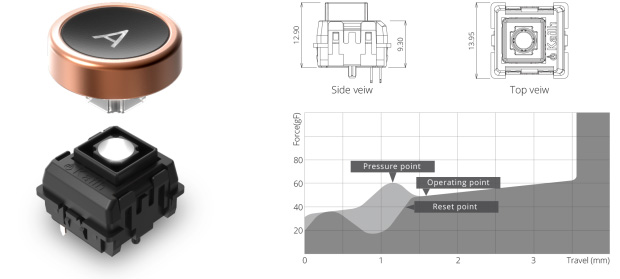Steampunk Surprise: Azio’s Retro Classic Mechanical Keyboards
There’s retro and then there’s retro, but the version that’s inspired by the look of old typewriters is alive and well. There are models like this one, and Azio launched a crowdfunding campaign to get its “Retro Classic Luxury Mechanical Keyboard” into the hands of consumers. (We might classify these keyboards as “steampunk” more than “retro,” but hey.)
You can choose from three color options: black with chrome accents (Retro Classic Onyx), white with copper accents (Retro Classic Posh), and black with copper accents (Retro Classic Artisan). We present for your enjoyment the Indiegogo launch video that Azio produced, which feels like a perfume ad (in a fun way):
Artisanal keyboards, you guys.
Ribbing aside, if you’re after a certain aesthetic, you could do much worse than these Retro Classic keyboards. In person, the black-and-chrome version, at least, downright sparkles, and upon first impression, it looks and feels high-end.
The first thing you’ll notice is that it’s heavy. The weight, coupled with the huge, circular rubber feet underneath, mean that this keyboard will not slide on any surface. At all.
The second thing you’ll notice is far more striking: It kind of actually sounds like a typewriter, in a way, at least moreso than most other keyboards with Blue switches on board. It’s far more muted than a real vintage typewriter, but it’s certainly evocative.
Mystery Switches?
Frankly, when we were typing away on this keyboard, the sound and the feel both threw us for a loop. The feel could be explained to an extent by the unique keycaps, but in any case, the typing experience wasn't one we'd encountered before. It turns out that’s because we’d never used these switches before.
Get Tom's Hardware's best news and in-depth reviews, straight to your inbox.
They look like Logitech’s Romer-G switches, with the through-stem lighting design, but they’re made by Kaihua. We first saw a sample of these switches at Computex 2016.
Azio told us that its keyboards are currently the only ones equipped with these switches. The company further claimed that Kaihua made the switches custom. That may be true, but considering that we already saw (at least a version of) these switches at Kaihua’s Computex 2016 booth, at best the switch maker just fiddled with the specs a bit to suit what Azio wanted.
Because we’ve never seen these switches anywhere else in the wild, we suspect that Azio served as a de facto beta tester for these Kailh switches.
However, we can infer that Azio had Kaihua customize the design enough, at least, that the company got to stick a proprietary name on them. Azio is calling them “Typelit Mechanical Switches.” Azio said in its materials that this is a modified Kailh Blue switch, but that’s specious; the only thing it has in common with a standard Blue switch is clickiness.
Azio wanted the switches to be both clicky and tactile to better simulate a vintage typewriter experience. The total travel is a bit shallower than a standard mechanical switch (3.6mm to 4mm), and the pretravel is a touch earlier, as well (1.6mm compared to 2-2.2mm). The Typelit switches claim an operation force of 50g (+/-10gf), with a range throughout the travel of 40-85gf.
It’s a big deal that these through-stem lighting switches are 1) made by Kaihua and 2) have emerged on the market. It’s no secret that through-stem lighting is generally a superior design compared to regular switches that have LEDs added on and even Cherry MX RGB-style switches with clear housings. Omron had that market cornered, though; we spotted some through-stem Omron switches on a Das Keyboard model at CES, and of course Omron is Logitech’s partner on the Romer-G switches. To see one of the two switch juggernauts develop a version means that the through-stem design could begin to gain some more mainstream appeal.
Keycaps, Stabilizers, And Lighting
Comically, the debut of these switches comes on a keyboard equipped with decidedly non-standard keycaps.
That’s not to say these caps are junk; they’re just quite different from what we’re all accustomed to typing on. They’re flat circles perched atop a stem. The plastic feels a little cheap all around. Azio stated that the shiny rings are electroplated plastic but didn’t specify what type. The plastic pillars are woefully thin, and looking closely, we could spot stress cracks beginning to appear after just a few days of use (and one mega teardown).
Azio further did not specify what type of lettering application it used on the legends, but to us they appear lasered. One note on the legends: According to an update on its Indiegogo page, Azio accidentally shipped out review units whose keycaps had primary and secondary characters flipped. On the unit we have, the primary legend sits above the secondary one; on the keyboards that ship to consumers, they'll be flipped.
The keyboard uses Cherry-style stabilizers.
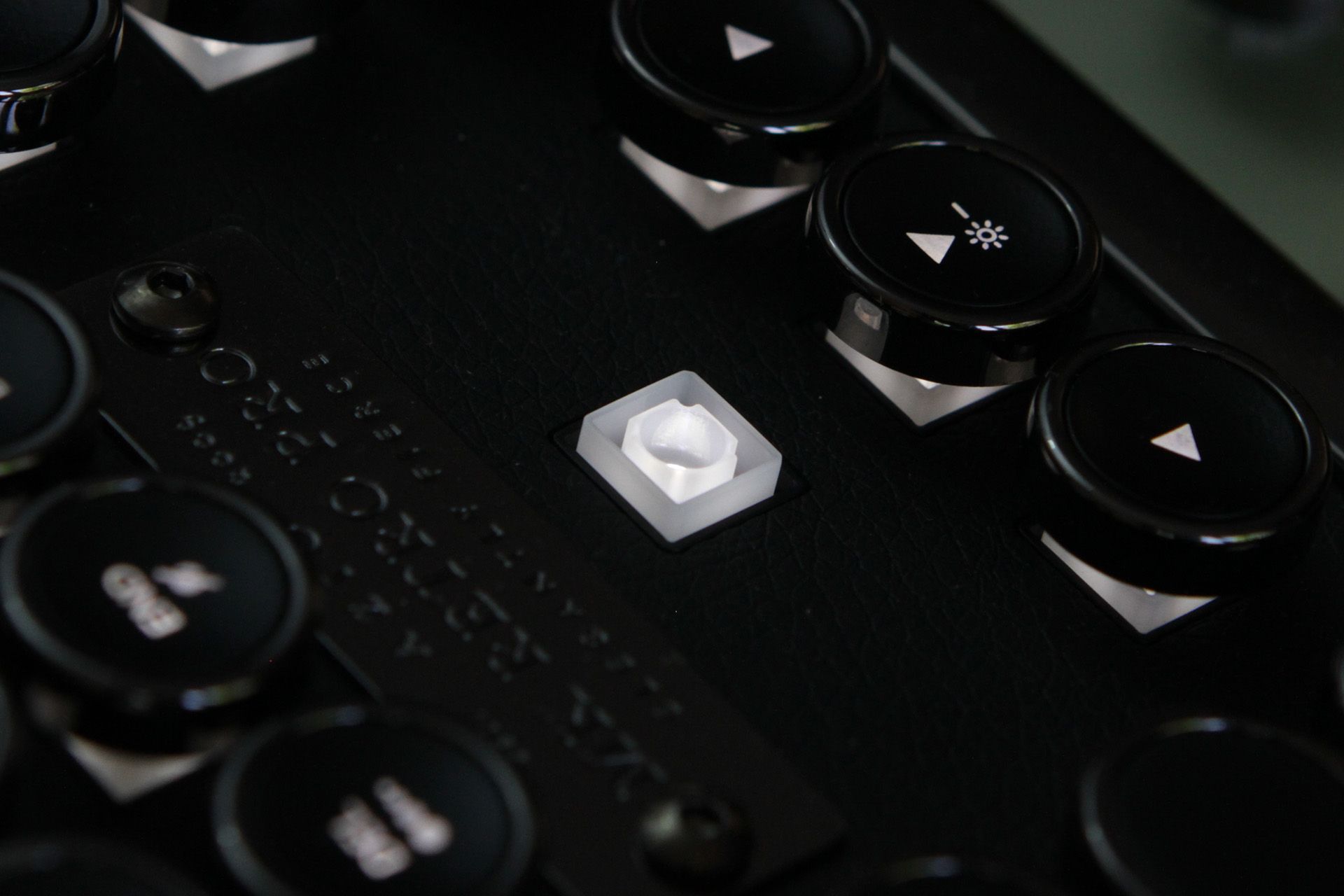
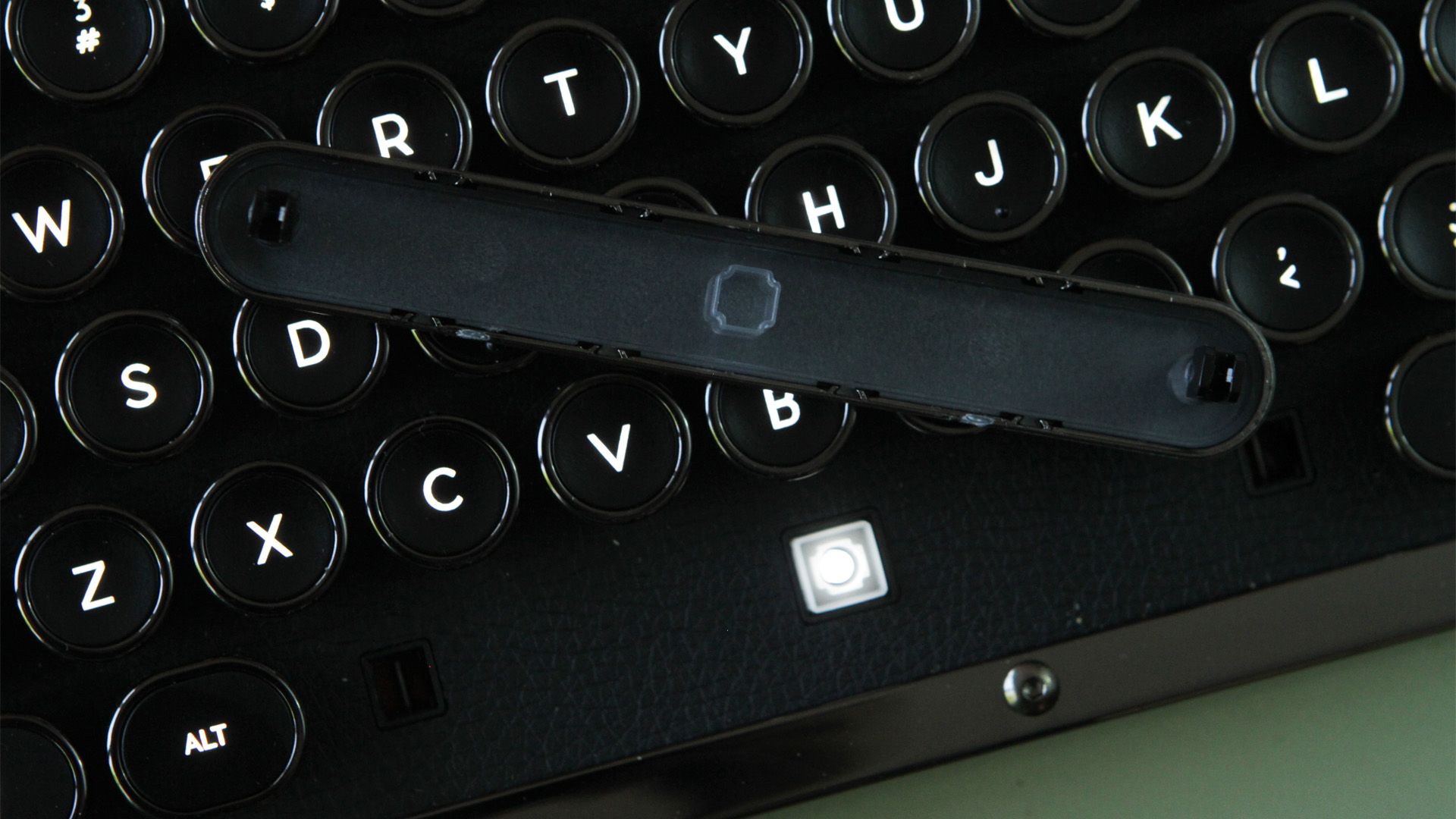


By dint of the through-stem lighting design, the keycap legends (which are quite large, by the way) are brightly backlit--even the secondary characters. Further, because the light is constrained within the translucent stems, there’s just a tiny bit of underglow, but it’s perfectly balanced from key to key. The only issue is that because the caps are thin, the stems are exposed, and their translucent glow becomes far too conspicuous. Normal caps would cover almost the whole stem, leaving just a subtle underglow.
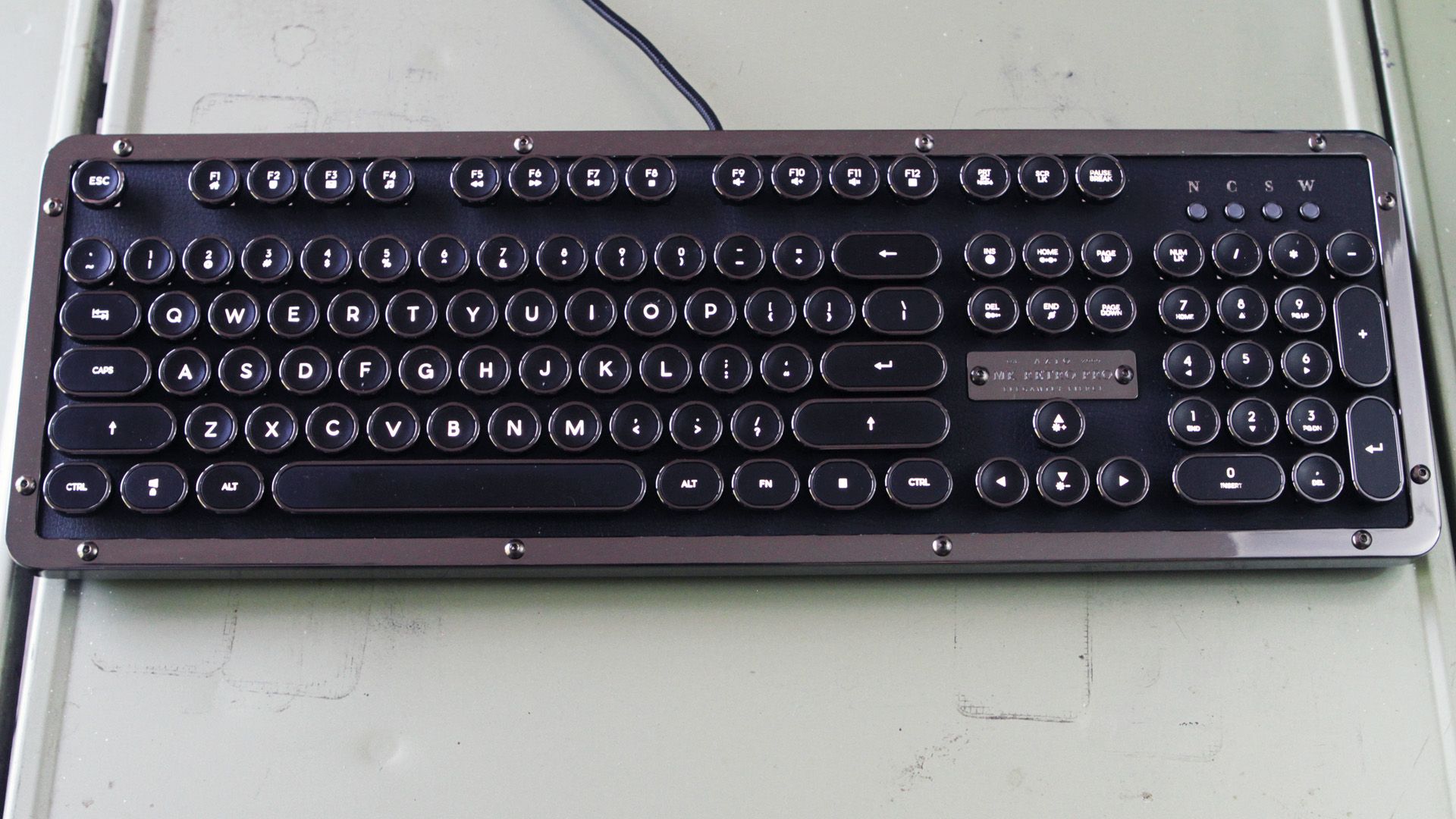
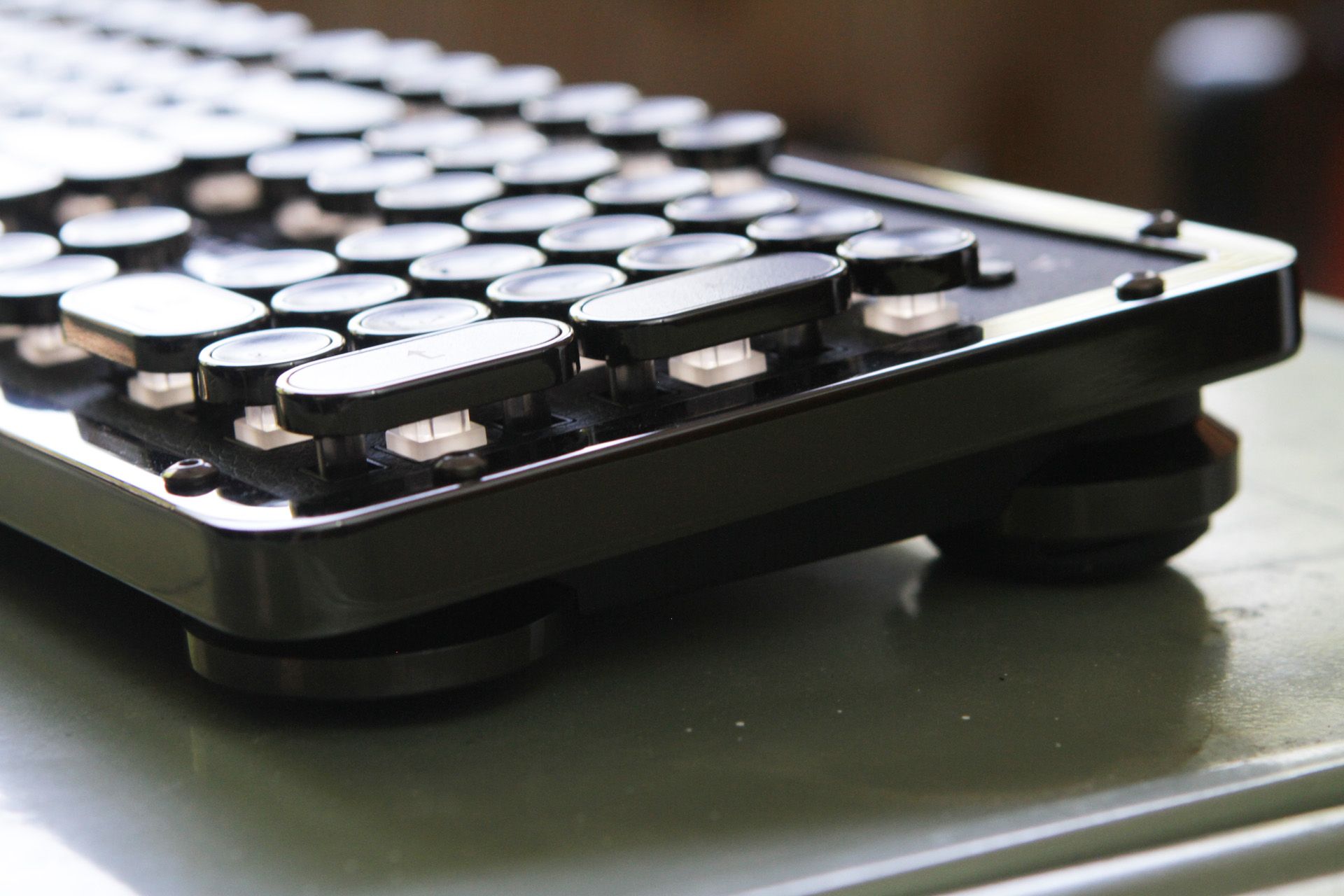
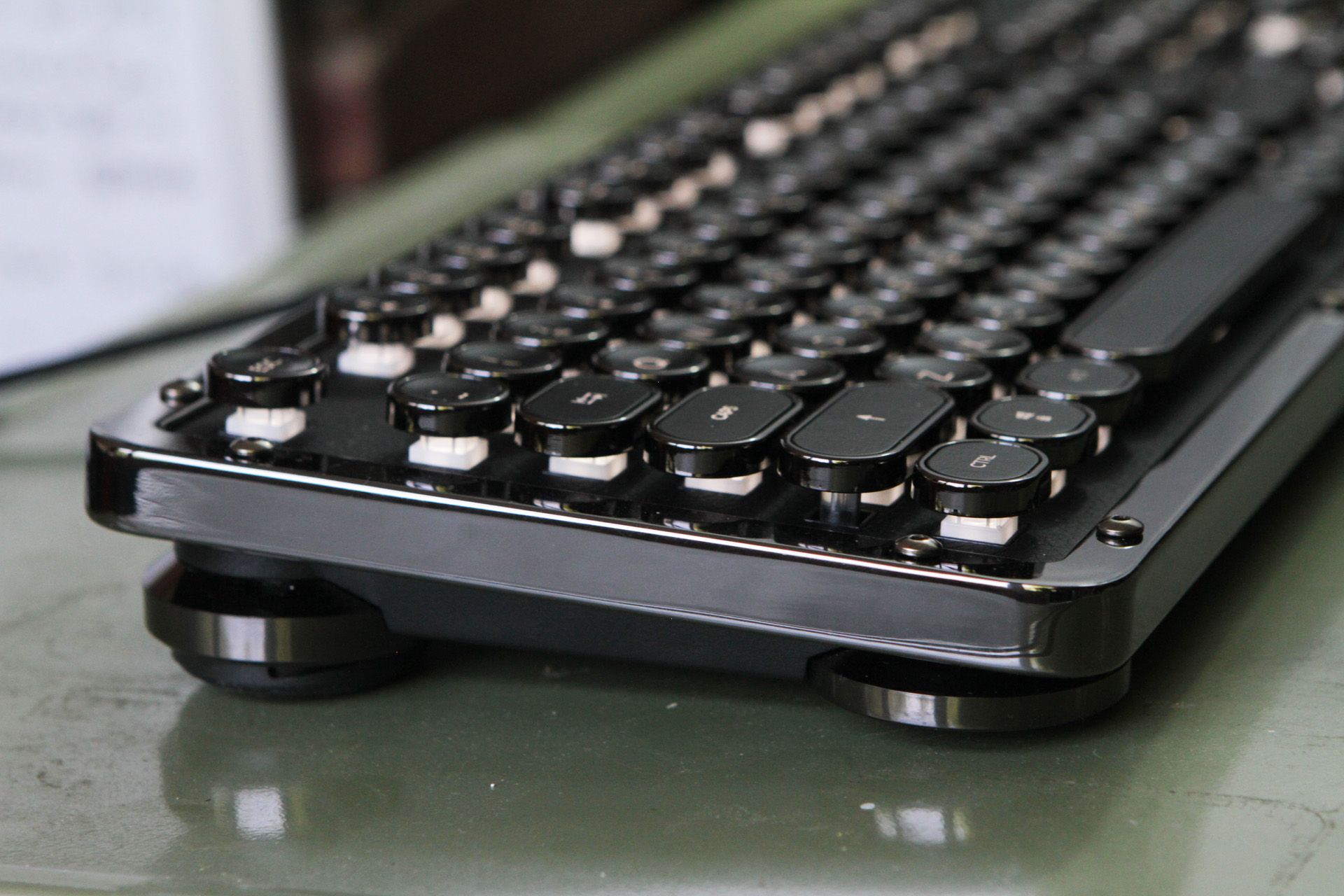
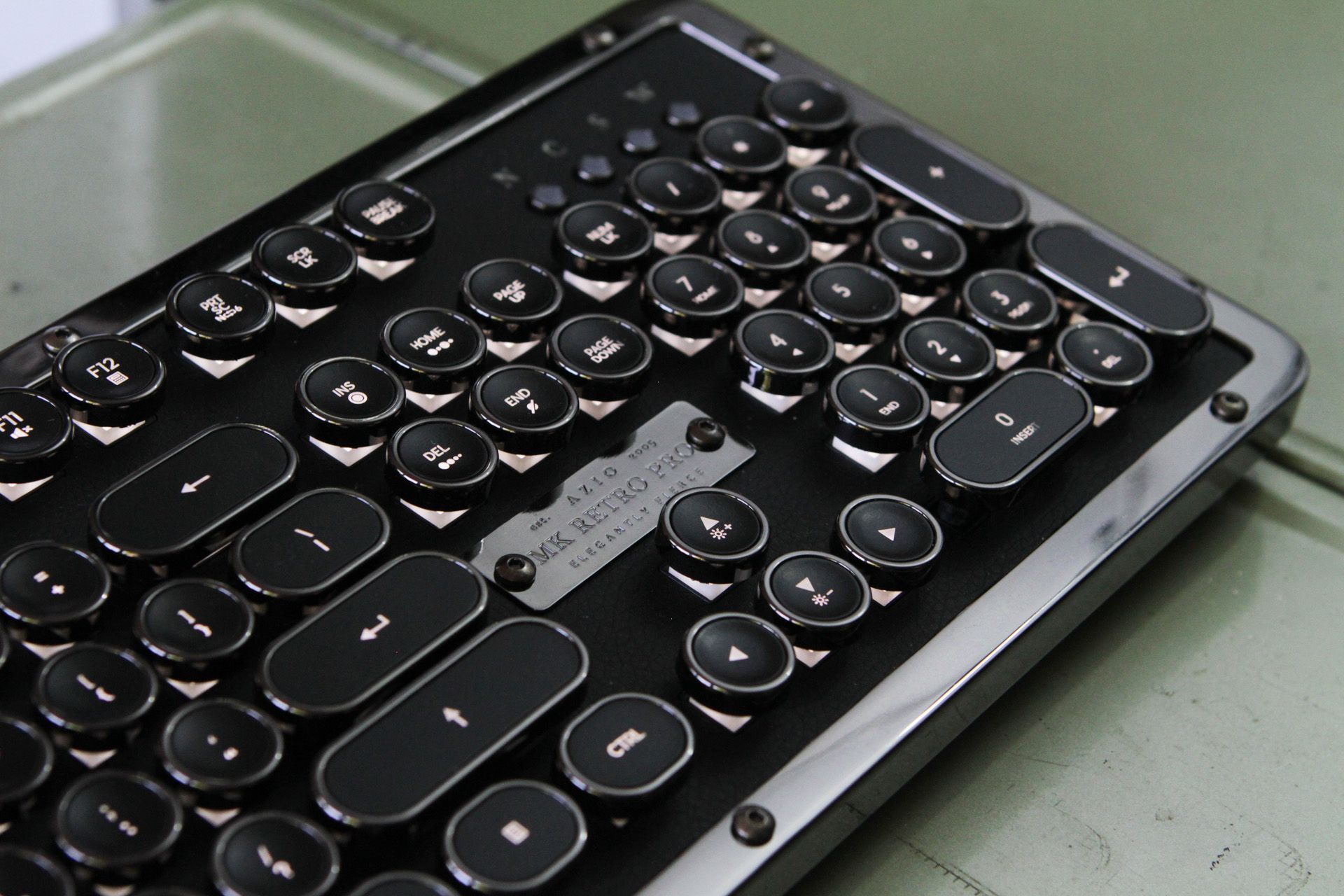


Teardown
Taking the Retro Classic apart is a bit of a chore. You have to remove all of the keycaps, of course. Twelve hex screws hold the metal frame onto the rest of the keyboard, and you’ll need to remove two more to pry off the nameplate. To remove the leather to plate, you’ll need to flip the keyboard over and remove 15 screws. Then, there are nine screws holding the backplate assembly onto the back of the chassis, and, finally, you need to pop the rubber covers off of the two bottoms to remove one screw from each.
Then, gently pry the whole thing apart.
What you’ll find is that the leather top cover hardly feels like leather--it’s quite thin, and it’s mounted onto whispy thin plastic. The bottom of the chassis is just plastic. However, the shiny metal frame around the edge of the keyboard is actually zinc aluminum alloy. (Azio said that “This alloy frame is corrosion free but through time and use, it will eventually start to bear weathering marks. This adds character to the product and is where we truly see the beauty of using genuine materials.”)
The backplate assembly is as solid as they come, though. The PCB is mounted onto a sturdy steel frame. The PCB itself is beautiful; it’s a sharp-looking red, and except for one bit of solder and one ever-so-slightly bent LED mount, it’s pristine.
The MCU is a Holtek HT68FB560. There's no separate LED controller--the Holtek chip does it all.
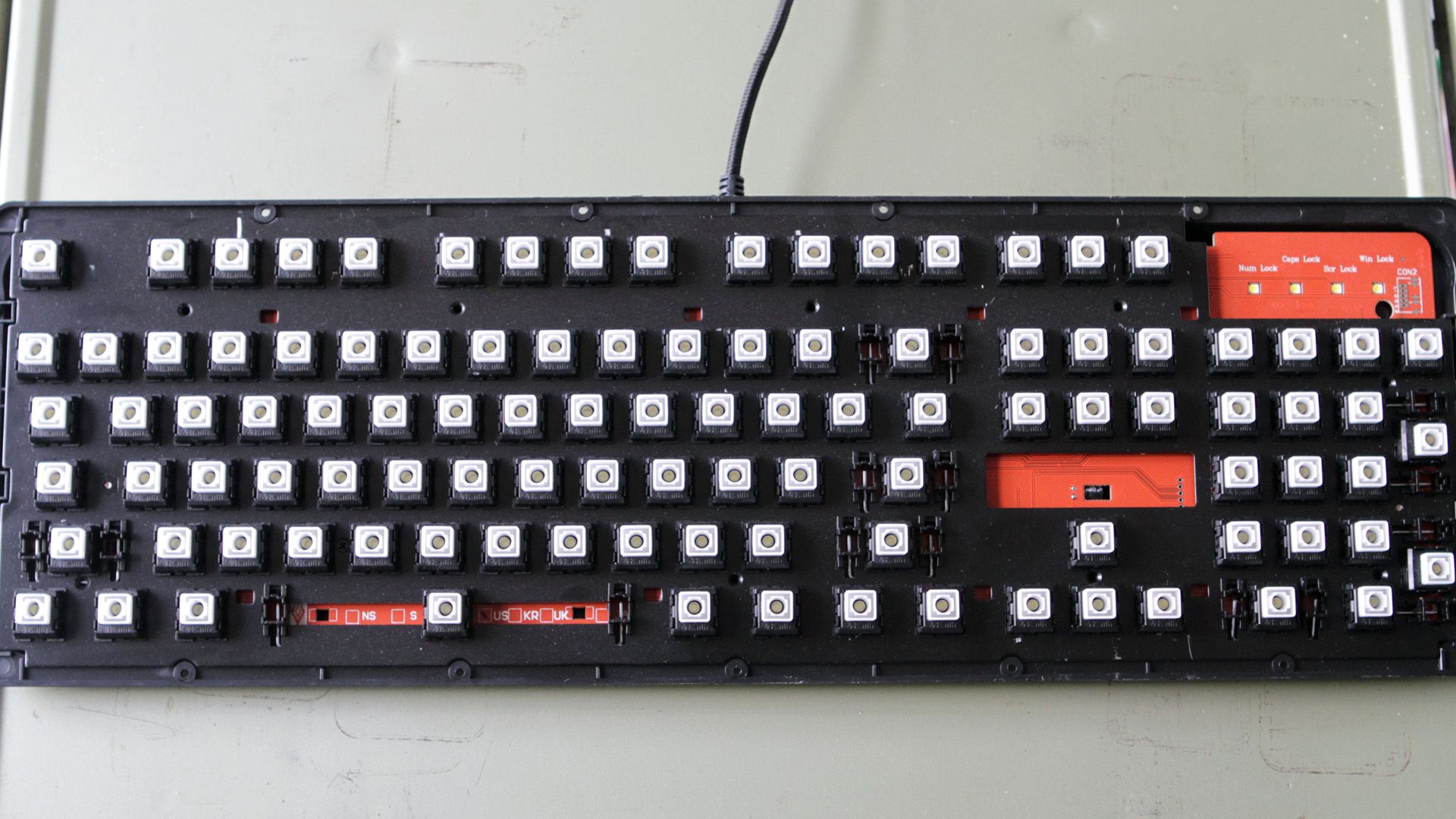


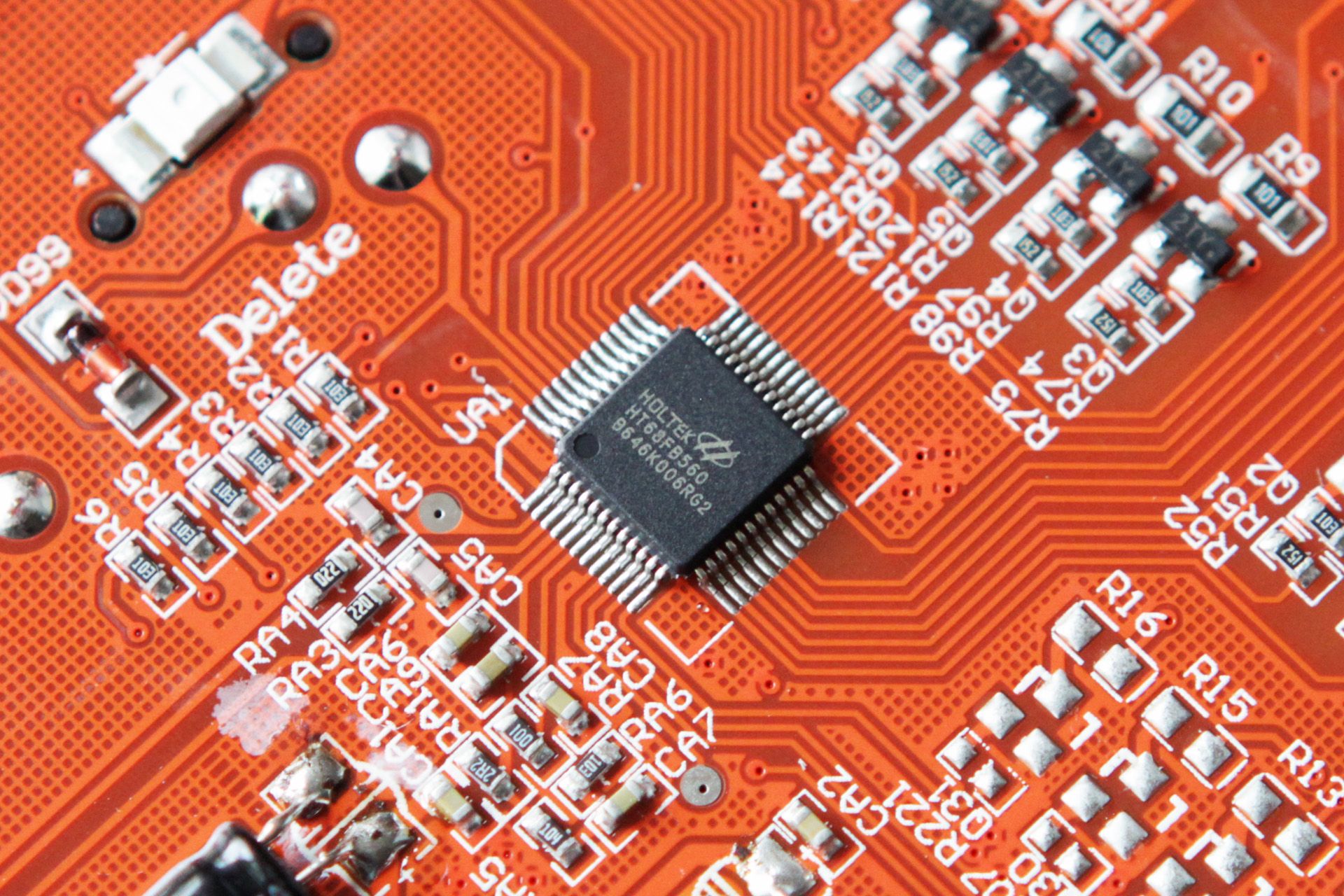
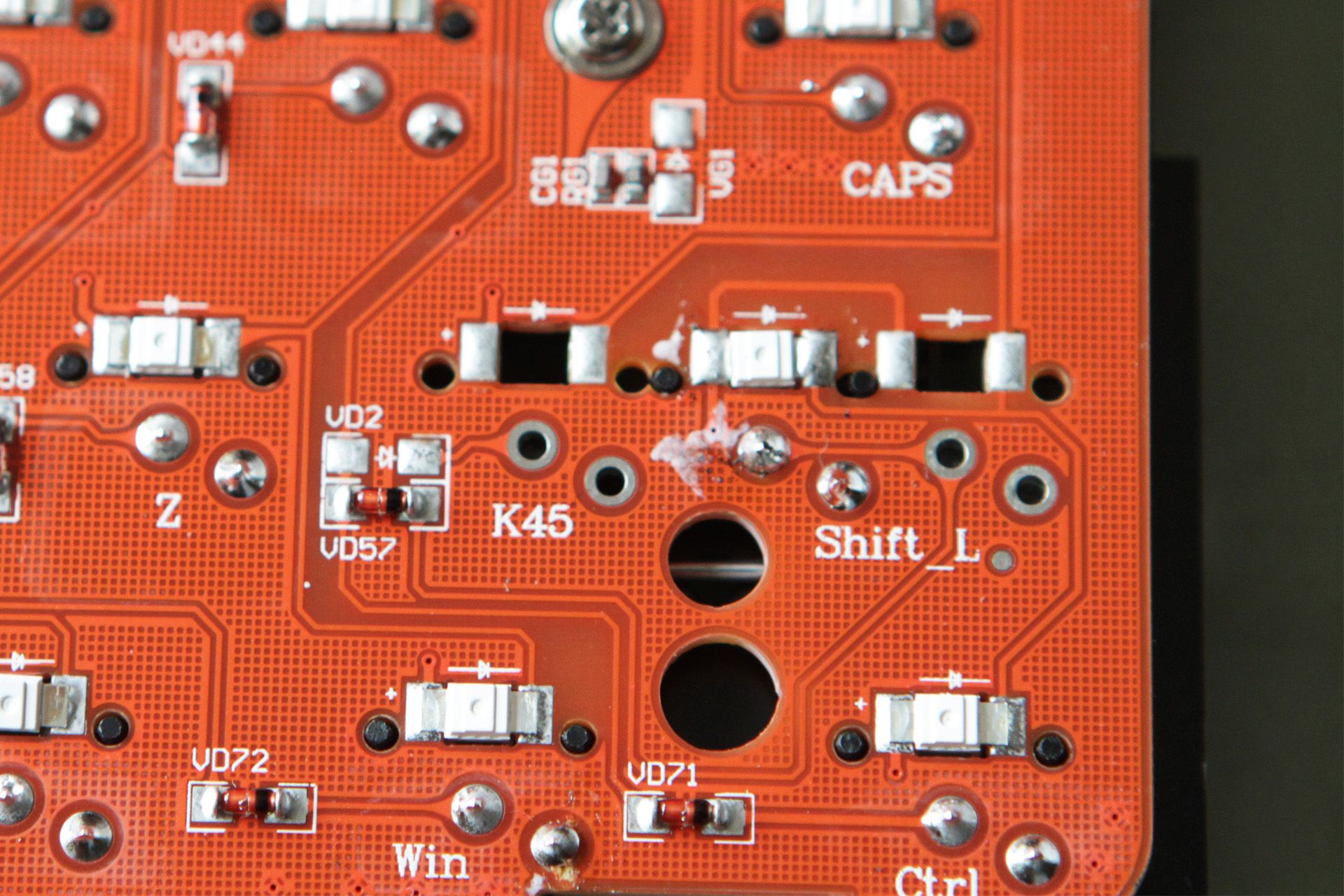
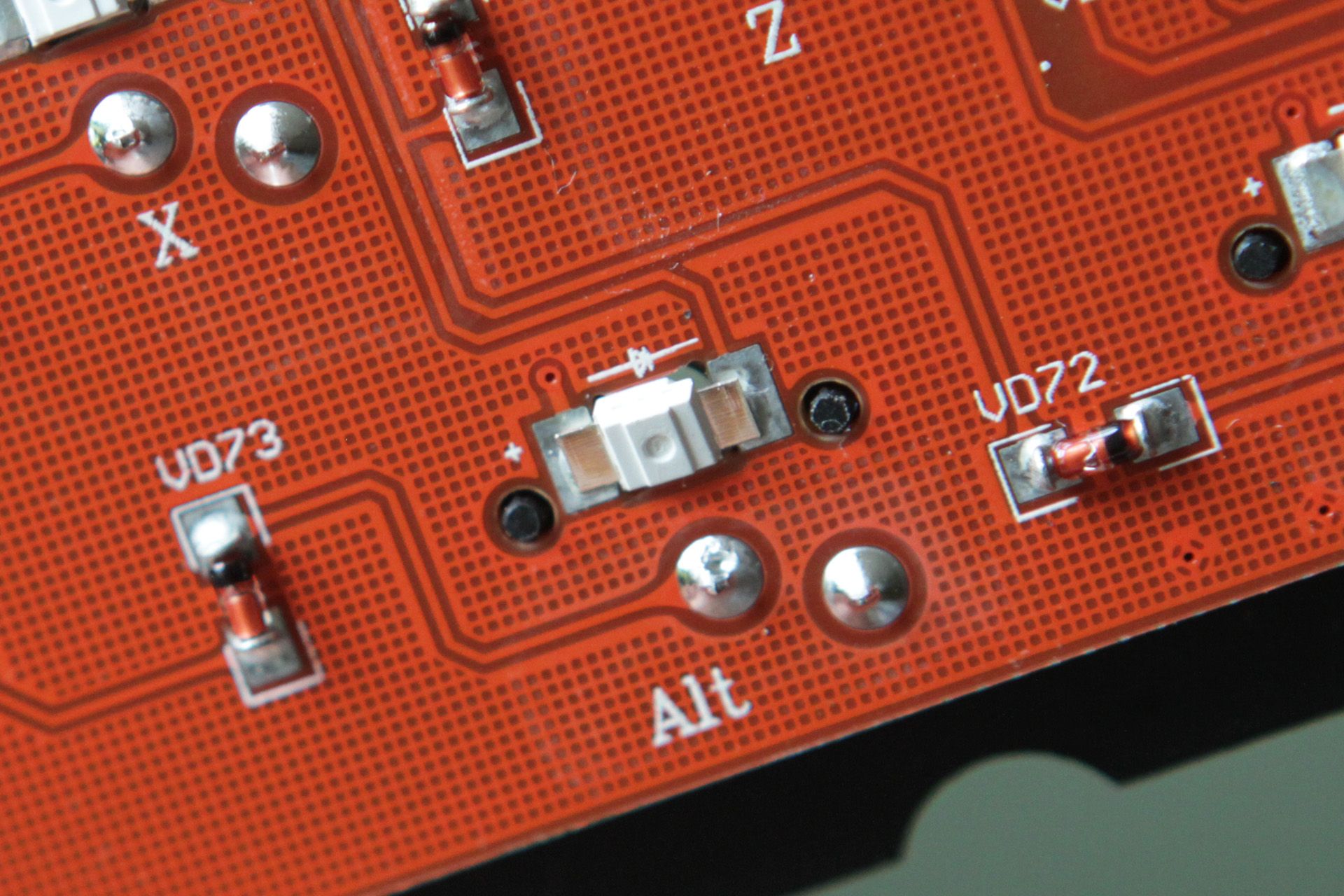
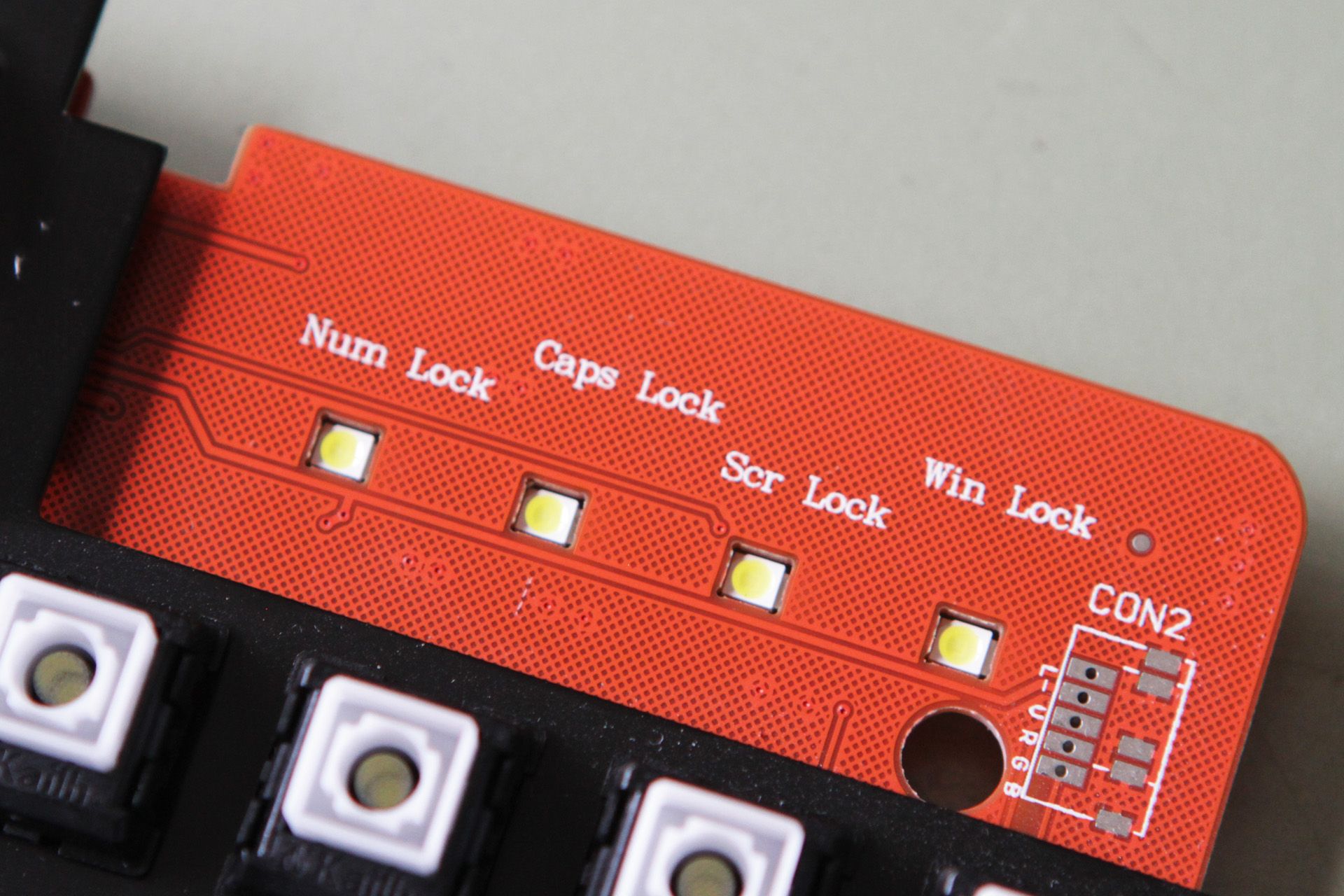
And All The Rest
Whether all the versions of the Azio Retro Classic are goofy or gorgeous is in the eye of the beholder, but Azio has done a good job of making a fine-looking and -feeling vintage keyboard.
The Retro Classic comes in both wired and wireless versions. The wired version is USB (but with a Type-C interface) and supports Windows layouts only. The Bluetooth version is designed to click with both Macs and PCs, though, and it can operate in either wired or wireless mode. The wired version is on track for late August shipping, and the hybrid wired/wireless model should ship in October.
There are switches on the back of the hybrid model that let you toggle between Mac/PC and wired/wireless. (You can also switch it to “off” to preserve the rechargeable built-in Li-ion battery for wireless mode.) To better support Mac users, you’ll get Mac function keycaps in the box.
You can order up a Retro Classic with U.S., UK, Portuguese, German, or Nordic layouts.
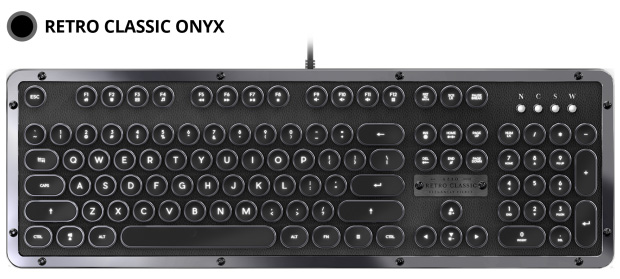
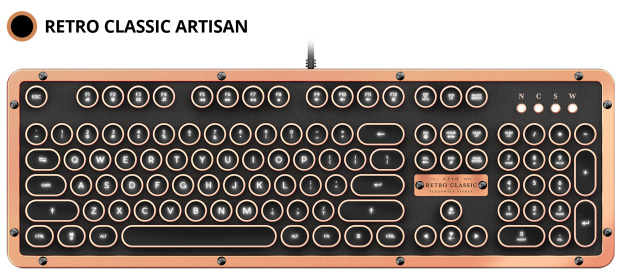

There’s no software with the Retro Classic keyboards, but you can control some things on-device, including the backlighting brightness. There’s also a bunch of hotkeys. One glaring omission is the inability to program macros, though.
Although Azio is already a manufacturer of keyboards, it’s chosen to use Indiegogo as a launch vehicle. It appears to be going well; at the time of this writing, Azio has destroyed its initial $10,000 goal and has easily surpassed the $100,000 mark. You can still snag a wired Retro Classic for $120 or a wired/wireless hybrid for $140. It’s unclear how much those prices will go up post-Indiegogo campaign, but we suspect this will be a limited run, so if you want one of these things, you should claim yours via the campaign now. There's just a few days left.
To be frank, the Retro Classic keyboards came off as a silly to us at first, but Azio delivered some pleasant surprises. The switches alone make this keyboard worth snapping up for enthusiasts who love to collect, but the subsequent excellent lighting, strong build quality, and pristine interior construction make this more than a steampunk fan’s delight.
| Header Cell - Column 0 | Azio Retro Classic |
|---|---|
| Type | Full size |
| Switch | Typelit Mechanical Switches (made by Kaihua)-Type: Tactile, clicky-Actuation force: 50gf-Actuation point: 1.6mm (+/-0.5mm)-Total travel: 3.6mm (+/-0.3mm) |
| Sensing Method | Conductive |
| Microcontroller | Holtek HT68FB560 |
| Onboard Storage | Unknown |
| Lighting | White LEDs, adjustable brightness |
| Key Rollover | NKRO (wired), 6KRO (USB mode, hybrid version) |
| Interface | USB Type-C, Bluetooth (hybrid version) |
| Cable | 6ft |
| Additional Ports | None |
| Key Caps | Plastic, non-traditional design |
| Dimensions | 147 x 455 x 40mm |
| Weight | 1,588g |
| Software | None |
| Construction | Zinc aluminum alloy top panel, plastic bottom chassis |
| Misc. | Windows, Windows + macOS (hybrid version)HotkeysMac legend replacements (hybrid version)6,000mAh rechargeable battery (hybrid version) |
| Price | $120 (wired), $140 (hybrid) |
Seth Colaner previously served as News Director at Tom's Hardware. He covered technology news, focusing on keyboards, virtual reality, and wearables.
-
The Paladin I like it and it doesn't sound any louder than this keyboard I currently use. (TTESPORTS Commander) found then at 1090.99 at frys.comReply
tempting. but hard to see myself gaming one. -
Kennyy Evony They tried too hard to make it a premium keyboard and failed. Their target audience would rather have keys cut from actual marble not cheap plastic. If you are pricing a product and target towards upper class, use natural rich and rare materials or fail.Reply -
Kennyy Evony clearly this is a paid advertisement propaganda article. i just had 2 of my comments removed for honest opinion.Reply -
dstarr3 *shrug* I like it, and it seems appropriately priced. I'd buy it if I were in the market for such a thing.Reply -
nimbulan So close...but copper? Copper?? Brass would not only be more appropriately retro, but look better too.Reply -
Rob1C Great in-depth analysis.Reply
I object to the word Steampunk being slapped on anything that is a little uncommon, it's like saying everyone with black hair is Goth.
Steampunk means that history was altered and that the present day version of the item is entirely different yet somehow familiar.
Steampunk is anachronistic technologies or retro-futuristic inventions.
More precisely, an alternative history of the 19th century's British Victorian era or American "Wild West", in a post-apocalyptic future during which steam power has maintained mainstream usage, or in a fantasy world that similarly employs steam power.
This Keyboard is missing a bit of tubing (maybe a lot), an Analog Meter (for Audio Level) and some Nixie Tubes (even LED lit) for the 'Lock Lights' in order to EARN the title "Steampunk Keyboard".
There are huge limitations to how different from a standard keyboard it can be as usability is key, ?? so a large divergence from the norm is unwanted (unless they truly reinvent a better wheel); a bit of copper coloring on one of three versions is not Steampunk.
They should have made it more TWX, but it's OK as is. Really well written and great analysis though.

